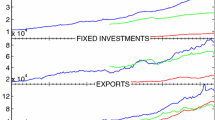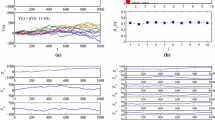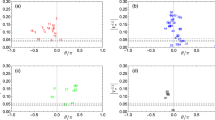Abstract
With the development of the global economy, interaction among different economic entities from one region is intensifying, which makes it significant to consider such interaction when constructing composite index for each country from one region. Recent advances in signal extraction and time series analysis have made such consideration feasible and practical. Singular spectrum analysis (SSA) is a well-developed technique for time series analysis and proven to be a powerful tool for signal extraction. The present study aims to introduce the usage of the SSA technique for multi-country business cycle analysis. The multivariate SSA (MSSA) is employed to construct a model-based composite index and the two dimensional SSA (2D-SSA) is employed to establish the multi-country composite index. Empirical results performed on Chinese economy demonstrate the accuracy and stability of MSSA-based composite index, and the 2D-SSA based composite indices for Asian countries confirm the efficiency of the technique in capturing the interaction among different countries.
Similar content being viewed by others
References
Marcellino M and Mazzi G L, Introduction to advances in business cycle analysis and forecasting, Journal of Forecasting, 2010, 29: 1–5.
Marcellino M, Leading indicators, Handbook of Economic Forecasting (eds. by Elliott G, Granger C W J, and Timmermann A), 2006, 1: 879–960.
Stock J H and Watson M W, New indexes of coincident and leading economic indicators, NBER Macroeconomic Annual (eds. by Blanchard O and Fischer S), MIT Press, 1989, 351–394.
Stock J H and Watson M W, A probability model of the coincident indicators, Leading Eco nomic Indicators: New Approaches And Forecasting Records (eds. by Lahiri K and Moore G H), Cambridge University Press, 1991, 63–90.
Stock J H and Watson M W, Forecasting using principal components from a large number of predictors, Journal of the American Statistical Association, 2002, 97: 1167–1179.
Forni M, Hallin M, Lippi M, and Reichlin L, The generalized dynamic factor model: Identification and estimation, Review of Economics and Statistics, 2000, 82(4): 540–554.
Forni M, Hallin M, Lippi M, and Reichlin L, The generalized dynamic factor model: Consistency and rates, Journal of Econometrics, 2004, 119(2): 231–255.
Artis M, Krolzig H M, and Toro J, The European business cycle, Oxford Economic Papers, 2004, 1–44.
Artis M J, Zenon G K, and Osborn D R, Business cycles for G7 and European countries, The Journal of Business, 1997, 70: 249–279.
Fidrmuc J and Korhonen I, Meta-analysis of the business cycle correlation between the euro area and the CEECs, Journal of Comparative Economics, 2006, 34: 518–537.
Forni M, Hallin M, Lippi M, and Reichlin L, Coincident and leading indicators for the Euro area, The Economic Journal, 2001, 111: 62–85.
Golyandina N, Nekrutkin V, and Zhigljavsky A, Analysis of Time Series Structure: SSA and Related Techniques, Chapman & Hall/CRC, New York, London, 2001.
Elsner J B and Tsonis A A, Singular Spectrum Analysis: A New Tool in Time Series Analysis, Plenum, 1996.
Hassani H, Zokaei M, von Rosen D, Amiri S, and Ghodsi M, Does noise reduction matter for curve fitting in growth curve models?, Computer Methods and Program in Biomedicine, 2009, 96(3): 173–181.
Hassani H, Heravi S, and Zhigljavsky A, Forecasting European industrial production with singular spectrum analysis, International Journal of Forecasting, 2009, 25(1): 103–118.
Ghodsi M, Hassani H, Sanei S, and Hick Y, The use of noise information for detecting temporomandibular disorder, Biomedical Signal Processing and Control, 2009, 4: 79–85.
Zhigljavsky A, Singular spectrum analysis for time series: Introduction to this special issue, Statistics and Its Interface, 2010, 3(3): 255–258.
Hassani H and Thomakos D, A review on singular spectrum analysis for economic and financial time series, Statistics and Its Interface, 2010, 3(3): 377–397.
Hassani H, Singular spectrum analysis: Methodology and comparison, Journal of Data Science, 2007, 5: 239–257.
Hassani H, Singular spectrum analysis based on the minimum variance estimator, Nonlinear Analysis: Real World Application, 2009, 11: 2065–2077.
Hassani H, Development of the theoretical and methodological aspects of the singular spectrum analysis and its application for analysis and forecasting of economics data, PHD Thesis, Cardiff University, 2009.
Hassani H, Dionisio A, and Ghodsi M, The effect of noise reduction in measuring the linear and nonlinear dependency of financial markets, Nonlinear Analysis: Real World Applications, 2010, 11: 492–502.
Hassani H, Zhigljavsky A, Patterson K, and Soofi A, A comprehensive causality test based on the singular spectrum analysis, Causality in Science, Oxford University press, Chapter 18, 2010, 379–404.
Golyandina N and Stepanov D, SSA-based approaches to analysis and forecast of multidimensional time series, Proceedings of the 5th St. Petersburg Workshop on Simulation (eds. by Ermakov S M, Melas V B, and Pepelyshev A N), St. Petersburg, 2005.
Patterson K, Hassani H, Heravi S, and Zhigljavsky A, Forecasting the final vintage of the industrial production series, Journal of Applied Statistics, 2010.
Lisi F and Medio A, Is a random walk the best exchange rate predictor? International Journal of Forecasting, 1997, 13: 255–267.
Hassani H, Soofi A, and Zhigljavsky A, Predicting daily exchange rate with singular spectrum analysis, Nonlinear Analysis: Real World Applications, 2009, 11: 2023–2034.
Hassani H and Zhigljavsky A, Singular spectrum analysis: Methodology and application to economics data, Journal of System Science and Complexity, 2009, 22: 372–394.
Rodryguez-Aragon L and Zhigljavsky A, Singular spectrum analysis for image processing, Statistics and Its Interface, 2010, 3: 419–426.
Broomhead D S and King G, Extracting qualitative dynamics from experimental data, Physica D, 1986, 20: 217–236.
Plaut G and Vautard R, Spells of low-frequency oscillations and weather regimes in the Northern Hemisphere, J. Atmos. Sci., 1994, 51: 210–236.
Hassani H, and Mahmoudvand R, Multivariate singular spectrum analysis: A general view and new vector forecasting approach, International Journal of Energy and Statistics, 2013, 1(1): 55–83.
Golyandina N and Usevich K, 2D-extension of Singular Spectrum 151 Analysis: Algorithm and elements of theory, Matrix Methods: Theory, Algo-152 rithms, Applications (eds. by Olshevsky V and Tyrtyshnikov E), World Scientific Publishing, 2010, 450–474.
Rua A and Nunes L, Coincident and leading indicators for the euro area: A frequency band approach, International Journal of Forecasting, 2007, 21: 503–523.
Anirvan B and Lorene H, A framework for measuring international business cycles, International Journal of Forecasting, 2001, 17: 333–348.
The Conference Board, Business Cycle Indicators Handbook, New York, 2001.
Nilsson R and Brunet O, Composite Leading Indicators for Major OECD Non-Member Economies: Brazil, China, India, Indonesia, Russian Federation, South Africa, OECD Statistics Working Papers, 2006.
Golyandina N, Usevich K, and Florinsky I, Filtering of digital terrain models by two-dimensional singular spectrum analysis, International Journal of Ecology & Development, 2007, 87: 81–94.
Atabek A, Evren E, and Saygin S, A new composite leading indicator for turkish economic activity, Emerging Markets Finance and Trade, 2005, 41: 45–64.
Jogen B P, Composite leading indicator for the Austrian economy, WIFO Working Papers, 2010.
Binner J M, Bissoondeeal R K, and Mullineux A W, Composite leading indicator of the inflation cycle for the Euro area, Applied Economics, 2005, 37: 1257–1266.
Victor Z and Ataman O, Time series decomposition and measurement of business cycles, trends and growth cycles, Journal of Monetary Economics, 2006, 53: 1717–1739.
Bandholz H and Funke M, In search of leading indicators of economic activity in Germany, Journal of Forecasting, 2003, 22: 277–297.
Burns A F and Mitchell W C, Measuring business cycles, National Bureau of Economic Research, 1946.
Author information
Authors and Affiliations
Corresponding author
Additional information
This research is supported by the National Science Foundation of China under Grant No. 71101142 and Presidential Award of Chinese Academy of Sciences.
This paper was recommended for publication by Editor WANG Shouyang.
Rights and permissions
About this article
Cite this article
Zhang, J., Hassani, H., Xie, H. et al. Estimating multi-country prosperity index: A two-dimensional singular spectrum analysis approach. J Syst Sci Complex 27, 56–74 (2014). https://doi.org/10.1007/s11424-014-3314-3
Received:
Revised:
Published:
Issue Date:
DOI: https://doi.org/10.1007/s11424-014-3314-3




